|
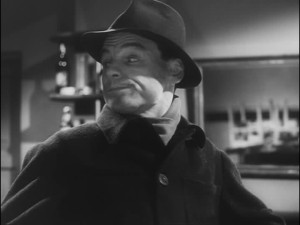
|
Killers (1956)
Andrei Tarkovsky as bar patron
|
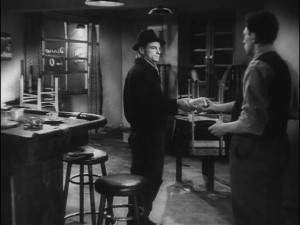
|
Killers (1956)
Andrei Tarkovsky as bar patron
In this scene, Tarkovsky whistles Lullaby of Birdland, a song about freedom by George
Shearing and B. Y. Forster, familiar to many Russians from VoA boradcasts.
|

|
Killers (1956)
Clock on the wall...
Short hand appears to be malfunctioning. But that's not not all... See the following screengrabs.
|

|
Killers (1956)
Clock on the wall...
Short hand appears to be malfunctioning. But that's not not all... There is a continuity problem:
At the start of the film, the large hand sits at 20 minutes. Now check out the following screengrabs.
|
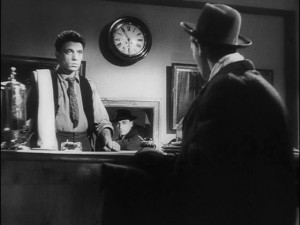
|
Killers (1956)
Clock on the wall... continued.
A few minutes later it points to rge 50-min mark...
|
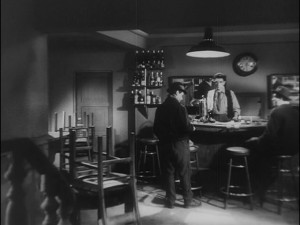
|
Killers (1956)
Clock on the wall... continued.
When customer Tarkovsky arrives, it points to 10 past (click to enlarge). Short hand still hasn't
budged. We deduce from this article that it was Andrei who
brought the crappy clock to the set: "The institute had very few props.
We brought everything from home, from relatives and friends. I remember Andrei brought
a round wall clock and his grandmother's small case...".
|
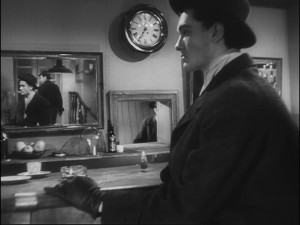
|
Killers (1956)
Crappy clock on the wall... continued.
When customer Tarkovsky departs (see him in the mirror, leaving), short hand has suddenly points to 7 hrs,
large hand points up. We guess they thought it was time to move that pesky small hand forward
by a bit. Click for larger image.
|
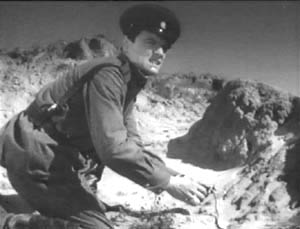
|
There Will Be No Leave Today (1958)
Meet Andrei Tarkovsky: A brave military engineer who specializes in sapping and other ultra dangerous field fortification activities!
"Hey, they're starting to eat their lunch without me! I better hurry up and disarm this here nasty mine!"
|
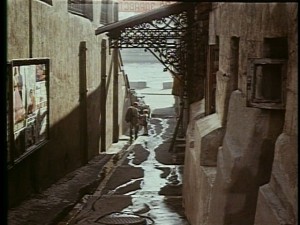
|
The Steamroller and the Violin (1960)
In this scene one may spot the shadow of camera and operator on the left.
|
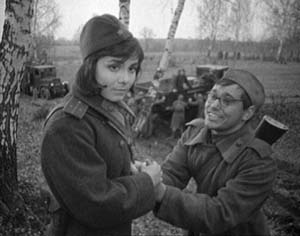
|
Ivan's Childhood (1962)
Starring.... Andrei-Michalkov Konchalovsky.
|
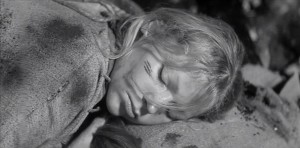
|
Andrei Rublev (1969)
"After Rublev comments that nothing is more terrible than snow falling in a temple, some of it lands
on Durochka's hair and is clearly a white feather" — from IMDB's "revealing mistakes".
(Click for enlargement.)
|
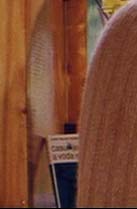
|
Solaris (1972)
Our Czech friends spotted what appears to be a Czech-language book in Solaris. Seen in the large framegrab above,
with detail shown on the left.
|
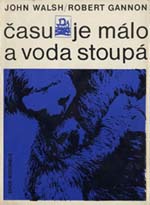
|
Solaris (1972)
Michal Petricek heroically scoured libraries and used bookstores in the Czech Republic, and actually
managed to track the book down. It's Walsh & Gannon's book on endangered animals in the Amazon
forest, Time is Short and the Water Rises. But, why in Solaris?
Perhaps it was placed in the frame because Tarkovsky and his Production
Designer Michail Romadin might have wanted a splash of a deep blue in the
predominantly naturally-coloured wooden frame. Why Chech book? Probably
because it was readily available and did not have Cyrillic lettering and a
specific Soviet feeling about it, thus eliminating all references to the
contemporary (1970's) Soviet Union. Plus the Chech printing quality was way
better than that in USSR at the time. Notice how carefully all Soviet references were removed/erased
from the film. Likely, Time and Water (from the title) had a special
significance here, however it can be a blessed coincidence...
|
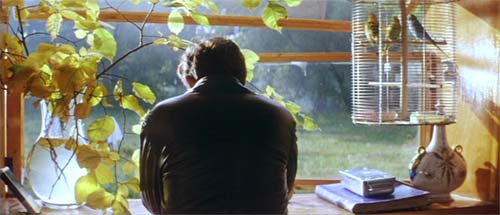
|
Solaris (1972)
Heh, our favorite treatise on endagered species of the Amazon forest now sits upside-down! What gives?
|
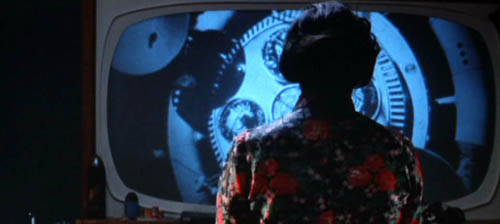
|
Solaris (1972)
In the televised report about Solaris, the voice if the reporter is Andrei Tarkovsky himself.
Michal Petricek commented on this (discovered this?) while preparing Czech subtitles for the
upcoming release in the Republic.
|
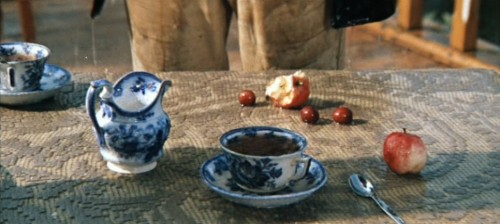
|
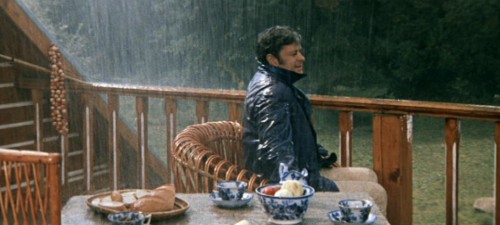
|
Solaris (1972)
Slight continuity problem. Dishes and fruit rearranged from one shot to the next. Oh well.
|
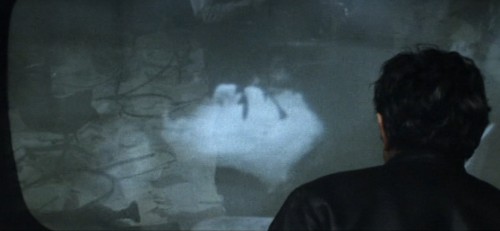
|
Solaris (1972)
Camera truck, cables, leg and sleeve of light shirt seen reflected in TV screen.
|
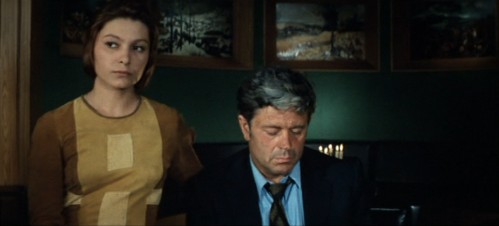
|
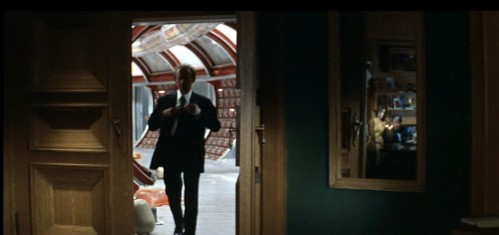
|
Solaris (1972)
Hari and Kris in library (top). In next shot coming dr. Snaut...
... and in mirror on the right of doore is reflexion Hari and Kris before other
background and in not be mirror conversely.
(Click on large view.)
|
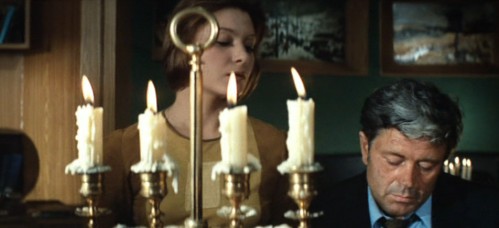
|
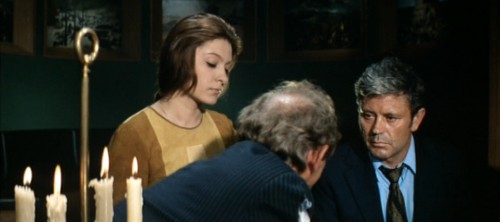
|
Solaris (1972)
Different candlesticks in successive shots.
|
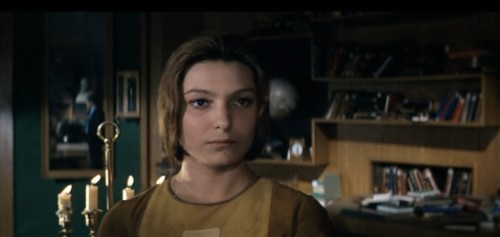
|
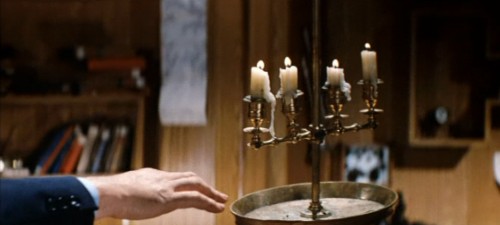
|
Solaris (1972)
In mirror shadow of camera and Kris seeing to camera, no to Hari.
|
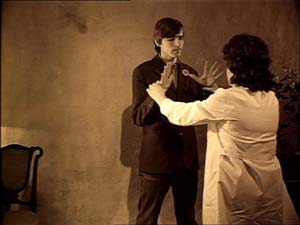
|
Mirror (1975)
Shadow of microphone on the wall. But this vindicate of character of scene - it's a tv shot in film.
|
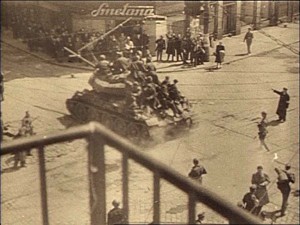
|
Mirror (1975)
Shots of end II. WW from Prague, capital of Czech republic.
|
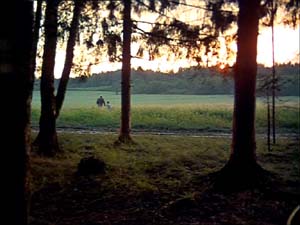
|
Mirror (1975)
Railway of camera truck in the right down.
|
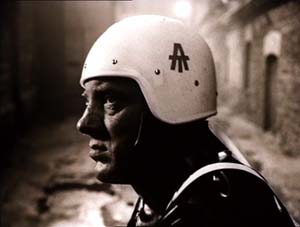
|
Stalker (1979)
Well-known monogram on helmet.
|
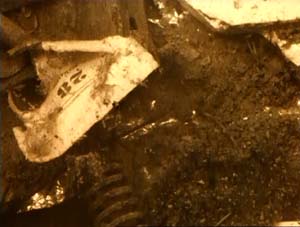
|
Stalker (1979)
Detail of calendar in apocalyptic sequention, some authors interpreting of "mystic" detail -
it is prediction date of Tarkovsky death? But - Tarkovsky death 29. dezember 1986 (ccc 2 after half-night),
number 28 this is only wish in non-reality... Wishing is the father of thought. (Trond, sorry, it's a very complicated translate for me)
(Click on large view.)
|
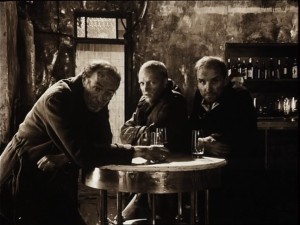
|
Stalker (1979)
Tiles wall in background...
(Click on large view.)
|
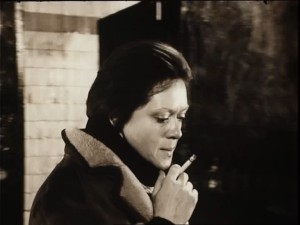
|
Stalker (1979)
seen also when wife departs bar...
|
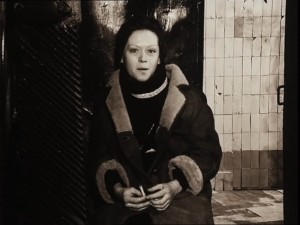
|
Stalker (1979)
...seein too in monologue wife after coming home. This scene was releasing
in snack bar and monologue was primary for professor and writer. In editing by
film it was changed...
|
Sacrifice (1986)
The Swedish book of Russian icon paintings Alexander receives as a gift in The Sacrifice
is Michail Vladimirovic Alpatov's Ryskt Ikonmĺleri (Russian Icon Painting). This Swedish edition
was published in 1984 on Gidlunds Förlag. 330 pages, 203 colour plates, captions in Russian and
Swedish, format 34.5 cm x 27 cm. ISBN 91-7021-433-6 (hardbound).
|
Nostalghia (1983)
The Russian folk song heard in Nostalghia is called Oi Vi Kumusciki.
|
Other
There is a Tarkovsky reference on the Jean Louis Murat CD called Cheyenne Autumn. At the end of the song of the same title, the last lyric is "Nostalghia" and a digital sample of Tarkovsky speaking (in Russian) loops as the song fades out.
|
Mirror
the bird flying out of AT's hand at the end is a finch. There were two of them, actually. Both very tame, one of them could not fly. http://www.4to40.com/earth/geography/htm/birdsindex.asp?counter=44
|
Mirror
Director Tarsem Singh gleaned from Tarkovsky the imagery for his R.E.M. Losing My Religion video, the set from which also makes an appearance in his The Cell.
|
Mirror
Q: We all know that "Stalker" is based on a book by the Strugatsky Bros., "Roadside Picnic." However, late in the film, the Writer delivers a long, complaining speech while seated on what looks like the end of a very long pipe (it's the scene where he drops a rock down the pipe and it takes forever to fall). What OTHER Strugatsky novel is this speech taken from?
A: "The Ugly Swans" ("Gadkie Lebedy" in Russian)
|
Mirror
Q: Poetry by Tyutchev and Arseni Tarkovsky is identified in the opening credits to "Stalker" as being recited in the film. However, there's an exception which is not identified: the recitation by the Stalker early in the second half of the film, beginning "When a tree is born, it is soft and weak..." Where does this come from?
A: Lao Tse, "Tao Te Ching"
|
Mirror
The Spanish film song in MIRROR, is a kind of folk music piece called "Rondeña" very popular on S XIX is typical of the city of Malaga. A kind of "Flamenco" Title: Navegando me perdà Sound clip here: Navegando_me_perdi-extract.mp3 Some info: http://flun.cica.es/mundo_flamenco/flamcd/b/b2/4.htm http://www.elchodronero.ch/rondenialetra.htm
|
Various
The Classical music used in Tarkovsky's films is as follows.
(a) Pucell Indian Queen.... etc... etc... Artemyev in one interview (in the "7 1/2" book) mentions
that AT liked a lot Bach's organ preludes (the "Orgelbuechlein", I presume) performed by Gari Grodberg
(a Russian organist, there are CDs of his performances although the CDs seem to be new recordings,
I don't know if there were any CD editions of Grodberg's old LPs from the '60s whicb Tarkovskly
presumably used for "Solaris" and "Mirror"). "St. John's Passion" - no idea. Possibly an "Eterna"
recording (the East German recording label) as they'd probably be more easily obtainable in the USSR
than a Western LP. Purcell's "Indian Queen" - again no clue about the performance except that the
performance seems typical for 1960s disregard for original instruments - still very beautiful - Act IV,
Orazia: "They tell us that your mighty powers above make perfect your joys and your blessings by love."
(etc.). Pergolesi - no idea.
|
Various
1. Purcell - Indian Queen (there is a good Naxos recording out). It's from Act IV, Orazia: "They tell
us that your mighty powers above make perfect your joys and your blessings by love." (etc.). We have no
clue about the actual performance (except that the performance seems typical for 1960s disregard for
original instruments - still very beautiful, of course!) 2. The end of the film: Bach - the opening
chorus of St. John Passion: Herr, unser Herrscher, dessen Ruhm In allen Landen herrlich ist! [Lord,
our master, whose glory is magnificent in all lands!] (something like that) This is the only text we
hear on the soundtrack since Bach in typical Baroque fashion repeats the verses about 127,455 times
before continuing further. 3. Father's return/portrait of Ginevra Benci: Bach - a snippet from St.
John Passion again: Und siehe da, der Vorhang im Tempel zeriss in zwei StĂĽck, von oben an bis unten
aus. Und die Erde erbebete, und die Felsen zerrissen, und die Gräber täten sich auf, und stunden auf
viele Leiber der Heiligen. [At that moment, the curtain of the temple was torn in two from top to bottom.
There was an earthquake, the rocks split, and the graves opened and many of God's people arose from sleep.]
4. The stratospheric balloon: Pergolesi - Stabat Mater, the penultimate part of the canonical Stabt Mater,
i.e.: Quando corpus morietur fac ut animae donetur Paradisi gloria. {When my body dies, let my soul receive
the glory of heaven.] This is again stretched by repetition. The full text of Stabat Mater can be found e.g.
at http://www.stabatmater.dds.nl/english.html 5. Anything else? Oh, the opening credits: Bach's chorale prelude
"Das alte Jahr vergangen ist" ("The old year now hath passed away") (BWV 614) from his OrgelbĂĽchlein (Organ Booklet).
See e.g. http://www.virtuallybaroque.com/track139.htm and also http://jsbach.org/das.html
|
|
|

|



